Kiteloops how to Heli Loop - Ride With Blake
Today we are going to go over how to do a heli loop.
This is a really great addition to any trick because it maximizes the wind window and allows for you to catch yourself on the way down. Heli loops are used as a tool for soft and smooth landings after a jump. A heli loop is a short loop at the top of the wind window, but is different than a kiteloop because it has no power. Heli loops are pulled after you reach the peak of your jump and, as you are descending, it catches you.
A heli loop is a vertical loop rather than a directional loop. It pulls you up and, if timed properly, can lift you back up into the air, hence the name “heli” loop. The thing to remember between a kiteloop, which gives you a strong pull, and a heli loop, which doesn't give you any power, is that a strong kiteloop is pulled before you reach the top of your jump.
We recommend you download the attached PDF on your phone. Check it before your next session!
This is a great loop to know because you're going to need it to land powered kite loops later, or to correct when the kite goes behind you on a large jump. You can also use heli loops to soften landings or spend a little more time in the air. However you choose to use it, the heli loop is an indispensable tool to have in your bag of kiteboarding tricks.
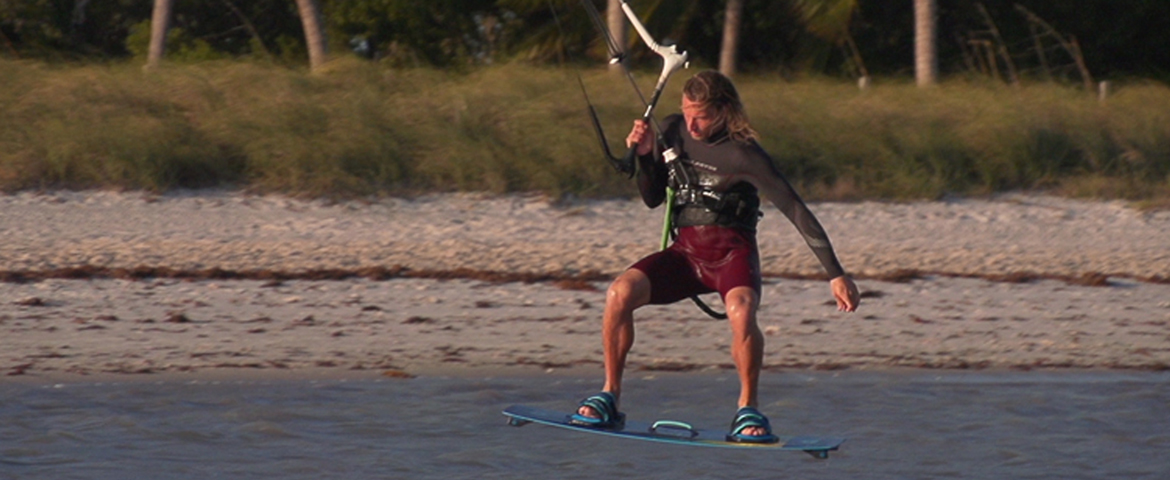 Pull as you start to come back down
Pull as you start to come back down
Step One- Timing of the Loop
Jump as you normally would, but wait until after you have reached the descent of your jump before pulling a loop. The reason for this is because a heli loop is used as a tool for softer landings. If you loop the kite at the apex or before, it will give you a hard yank, which is not the goal of this trick.
Right as you reach the apex and you feel yourself coming down, pull a tight loop above your head. Even if you accidentally land before completing the loop, it will soften the impact.
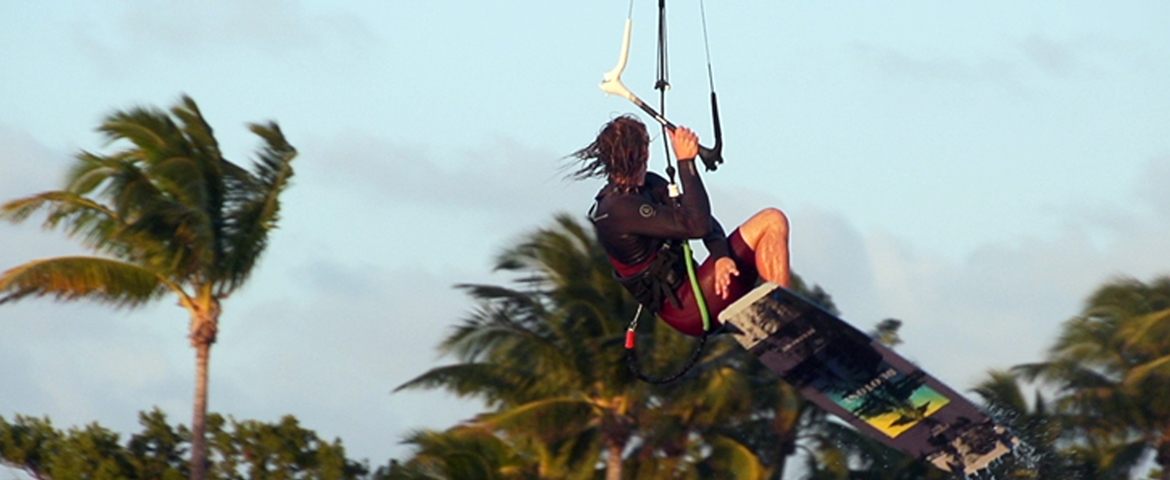
Pick a direction
Step Two- Pick a Direction
A heli loop can be done either way, forwards or back. So it’s up to you to choose which way depending on the jump. Whichever side of the wind window your kite is on as you are coming down should be the way you pull the loop. Most of the time you will probably end up pulling in on your back hand, but this loop can be pulled anywhere in the wind window as a parachute to catch you on the way down.
The kite can be somewhat at the edge of the wind window, but most important is that you loop it above your head. If you pull it into the power zone, it's going to become a late downloop or a late kiteloop.
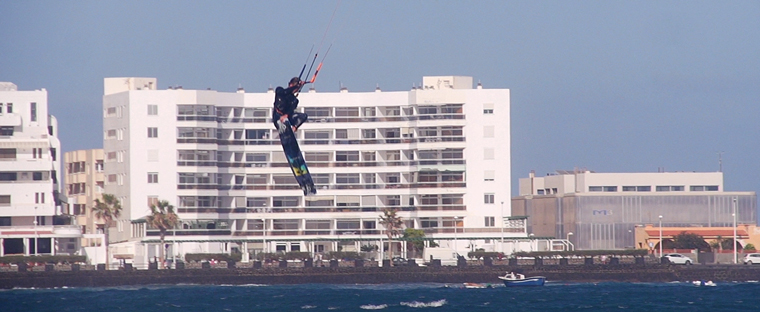
Pull Hard
Step Three- Pull Hard on the Bar
Just like the other loops, you want to pull hard on whichever side of the bar you’re pulling the loop. Pull with the back hand and push with the front hand, or vice versa. Your loop will arc at the edge on top of the wind window, giving you lift and catching you on the way down. Most importantly, don’t let go of the loop until it has completed its rotation and is traveling upwards.
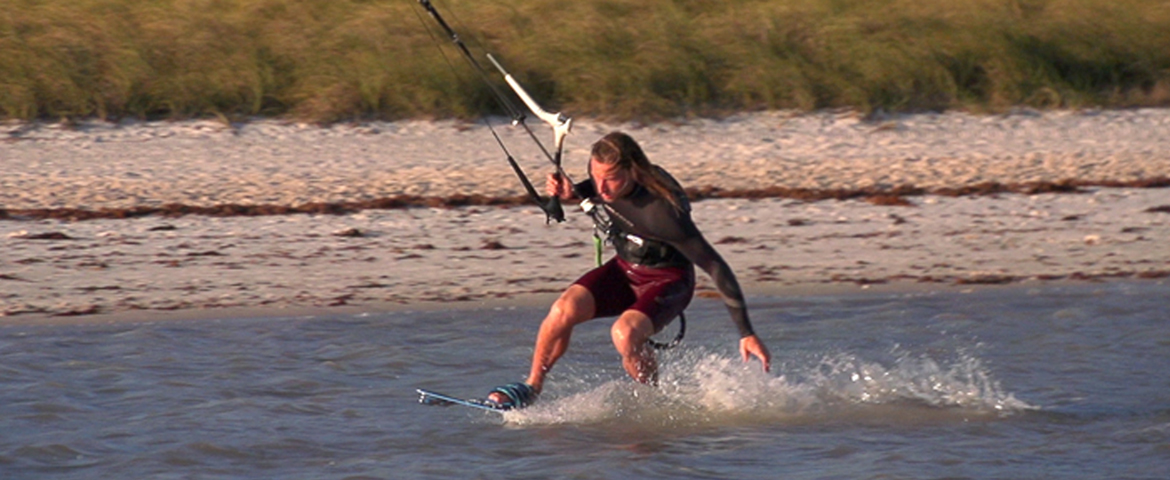 Land flat but prepare to edge once you have control
Land flat but prepare to edge once you have control
Step Four- Point the Board Downwind
I'm sure you are starting to recognize this step from all of our videos. For all loops, it's recommended that you land with your board pointed downwind. The reason for this is that a looping kite generates a lot of downwind pull and can result in hot landings. Heli loops are meant to give you soft, cushy landings but it’s still important to land downwind for the smoothest and easiest of touchdowns.
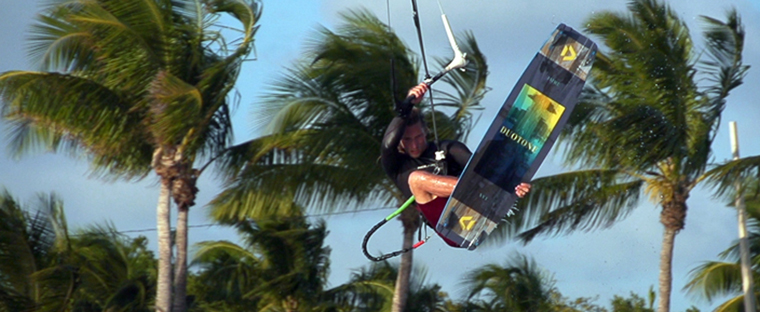
Redirect the kite so it doesn't get behind you
Step Five- Redirect the Kite
Now that the kite has looped overhead, your board is pointed downwind and you are preparing for landing, you’ll have to do something with the kite. After a heli loop you can steer the kite in the direction you want to go by simply pulling in on your front hand. Or, if you need it to go the other way, you can redirect it with a downloop or send it in the other direction.
The reason you can’t simply do the heli loop and let it be is because it’s going to be shooting straight up above your head and will need some direction as to where to go. The heli loop catches you and then needs some additional assistance.
Recommended Gear
When it comes to kiteloops, most kites will get the job done, especially for beginners. That said, some gear does work much better than others. A great rule of thumb is to learn on something no bigger than a 11 or even 10 meter. Larger kites will still loop but they are much slower, more difficult, and not very effective. There are several categories of kites that cater to different styles of riding. We much prefer the freestyle kites in most brands' line-ups. That said, many of the freeride kites work. To demonstrate this, we used the Cabrinha Switchblade 11 to film the majority of this list.
For intermediate to advanced kiteboarders
The fastest, most powerful kites for loops fall in the crossover category. These are three-strut C Hybrid kites designed specifically with kitelooping in mind.
Duotone Dice - Cabrinha FX - Liquid Force NV - Naish Dash - Cabrinha Switchblade 11m
The Switchblade is an outlier on this list. It's technically a freeride kite. The FX is superior in speed and arc, yet the Switchblade packs some power. We chose to film with this kite due to its powerful low end. As we were filming in the Keys, the wind could be quite light. We don't recommend going larger than the 11 for kiteloops unless you are an advanced kiteboarder.
For newer to intermediate kiteboarders
These are faster freeride kites. They're not designed specifically for kiteloops, but as they are all faster they work quite well. They also tend not to be as powerful when looping. The RPM might be the most powerful on this list.
Duotone Evo - Cabrinha Moto - Slingshot RPM - Naish Pivot
These are just a few kites that we prefer. There are plenty of good options beyond these. If you already have a freeride kite and are new to loops, switching to a crossover kite will not make or break your progress. It will, however, help. If you are a more advanced rider, chances are you've already made the switch to something designed with loops in mind. Either way you go, we encourage you to simply have fun with it. Kiteloops can be scary and, like any kiteboarding trick, they can be frustrating. Take your time and learn to enjoy the process.
-Written and produced by Blake Olsen & Ryan (Rygo) Goloversic.
 Blake Olsen
Blake Olsen
A Michigan boy through and through (even though he was born in Saudi Arabia), Blake is a youth with a lifetime of experiences and adventures. Not only that, he's passionate about sharing his zest for life with others. He is proficient at many fields, including kiteboarding and acting as concierge to any who simply ask. Looking for an adventure? Well, Blake is your guy. From sailing the Gulf and the Caribbean to backpacking Hawaii and Southeast Asia, he knows his stuff and can make your vacation into an adventure.
Webpage: BlakeTheOlsen.com
Instagram: @BlakeTheOlsen
 Ryan (Rygo) Goloversic
Ryan (Rygo) Goloversic
Just a dude from a kite shop testing all the gear one session at a time.
Many people dream of quitting their job, traveling the world and pursuing their passions. Rygo is one of those people who pulled the trigger. A few years into a postal career, he decided to change everything and travel as a kiteboarder, freelance videographer & writer. His mission is to help people and share the stoke. Get out there and kite!
Producer of: Ride with Blake I Sessions I Versus I Destinations I Foil Fridays
Recent Posts
-
Kiteboarding | Crafting the Harlem Force Kite with Sustainability and Performance
Unparalleled Performance Meets Unmatched Sustainability The kiteboarding industry is on …24th Apr 2024 -
Duotone Ventis 2025 | What's New?
If you're familiar with Duotone's Ventis, you know its specialty is freeriding in light wind …23rd Apr 2024 -
Duotone Ventis D/LAB 2025 Overview
If you ride in an area with multiple light wind days and need a wing that'll let you get o …23rd Apr 2024





